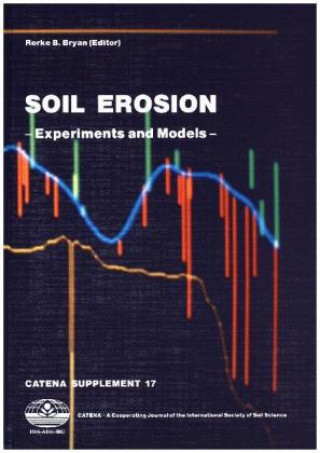
Kód: 15196202
Soil Erosion
Autor Rorke B. Bryan
The papers contained in this volume were amongst those presented to a conference on "The role of laboratory and field experiments in soil erosion research and modelling of hillslope development" held at the Scarborough Campus of t ... celý popis
- Jazyk:
 Angličtina
Angličtina - Väzba: Pevná
- Počet strán: 208
Nakladateľ: Schweizerbart'sche Verlagsbuchhandlung, 1990
- Viac informácií o knihe

74.56 €
Bežne: 74.61 €
Ušetríte 0.05 €
Dostupnosť:
50 % šanca Máme informáciu, že by titul mohol byť dostupný. Na základe vašej objednávky sa ho pokúsime do 6 týždňov zabezpečiť.
Máme informáciu, že by titul mohol byť dostupný. Na základe vašej objednávky sa ho pokúsime do 6 týždňov zabezpečiť.Prehľadáme celý svet
Mohlo by sa vám tiež páčiť
Darčekový poukaz: Radosť zaručená
- Darujte poukaz v ľubovoľnej hodnote, a my sa postaráme o zvyšok.
- Poukaz sa vzťahuje na všetky produkty v našej ponuke.
- Elektronický poukaz si vytlačíte z e-mailu a môžete ho ihneď darovať.
- Platnosť poukazu je 12 mesiacov od dátumu vystavenia.
Informovať o naskladnení knihy
Zadajte do formulára e-mailovú adresu a akonáhle knihu naskladníme, zašleme vám o tom správu. Postrážime všetko za vás.
Viac informácií o knihe Soil Erosion
Nákupom získate 187 bodov
 Anotácia knihy
Anotácia knihy
The papers contained in this volume were amongst those presented to a conference on "The role of laboratory and field experiments in soil erosion research and modelling of hillslope development" held at the Scarborough Campus of the University of Toronto in April, 1989. The conference was held in association with the formal opening of a new Soil Erosion Laboratory at the campus. The conference was intended to draw together people active in soil erosion and hillslope geomorphic research to examine recent progress and to discuss priorities and approaches for future research. While many active researchers were inevitably unable to attend, the conference did attract representatives from more than a dozen countries and many different disciplines. The papers presented a good cross-section of different approaches to soil erosion and hillslope research, including field monitoring, field and laboratory experiments and theoretical modelling, and touched on almost all the topics of current importance, with examples from many different environments. Traditional, long-established methods of soil erosion research were reflected by Fullen's1 study of erosional trends on agricultural soils in central England using monitored, instrumented erosion plots under natural rainfall. Dunne1, on the other hand, carried out a detailed study of rill-interrill process on experimental field plots under simulated rainfall and applied the results in a model of long-term slope evolution in the southern Kenyan grasslands. These experiments demonstrated the critical role of vegetation in the hydrological and hydraulic response of semi-arid hillslopes. This was also reflected by large-scale simulated rainfall experiments carried out on rocky hillslopes at Walnut Gulch, Arizona, by Abrahams, Parsons & Luk. The studies by Dunne and by Abrahams et al. both focussed closely on hydraulic conditions in shallow overland flow under intense rainfall, and this topic was returned to in a number of experimental laboratory studies using simulated rainfall. Kinnell studied the interaction of rainfall intensity, flow depth and flow velocity on sediment entrainment in a small laboratory flume, while Guy & Dickinson used rather similar methodology in demonstrating the difficulty of accurate predictions of hydraulic thresholds for sediment entrainment using the Shields criterion. Torri, Biancalani & Poesen also found problems in using the Shields criterion for shallow overland flow, particularly in the situation where coarse gravels rest on steep, cohesive rill beds of much finer texture. In an examination of conditions for the incipient movement of rock fragments, they used empirical results from small flume experiments to test a model by NADEN (1987) which examines incipient gravel instability in terms of average flow velocity and turbulent velocity fluctuations. Apart from focussing on the Shields criterion, Guy & Dickinson also emphasized the importance of accurate assessment of relative roughness for prediction of sediment entrainment in shallow flows. This problem was also addressed in papers by Govers1 and Rauws which reported experimental laboratory studies from Leuven and Caen. BRYAN also examined critical hydraulic thresholds in a study of rill initiation, headcut and knickpoint development in a large laboratory flume under simulated rainfall, and provided further information on the processes of cyclic rilling and colluviation described by Bryan & Poesen (1989). De Ploey examined the problem of knickpoint and headcut development at field scale in a study of thalweg gullying on loess soils in Europe, which further developed some of the theoretical concepts first presented in a theoretical model of headcut retreat by De Ploey (1989). The papers which examined patterns and processes of erosion in a framework of shallow flow hydraulics were paralleled by a series of papers which examined time-dependant variations in soil resistance t
 Parametre knihy
Parametre knihy
74.56 €
- Celý názov: Soil Erosion
- Podnázov: Experiments and Models
- Autor: Rorke B. Bryan
- Jazyk:
 Angličtina
Angličtina - Väzba: Pevná
- Počet strán: 208
- EAN: 9783510653584
- ID: 15196202
- Nakladateľ: Schweizerbart'sche Verlagsbuchhandlung
- Hmotnosť: 650 g
- Rozmery: 240 × 170 × 15 mm
- Rok vydania: 1990
Obľúbené z iného súdka
-

Gravity Falls Journal 3
16.39 € -23 % -

Berserk Deluxe Volume 1
44.37 € -11 % -

Berserk Deluxe Volume 2
52.22 € -

White Nights
3.51 € -23 % -

It ends with us
8.75 € -18 % -

48 Laws Of Power
18 € -9 % -

A Little Life
17.50 € -

Berserk Deluxe Volume 3
48.80 € -2 % -

Atomic Habits
16.19 € -29 % -

Surrounded by Idiots
10.46 € -29 % -

Jujutsu Kaisen, Vol. 23
9.75 € -26 % -

The Official Stardew Valley Cookbook
22.33 € -22 % -

The 48 Laws of Power
24.55 € -5 % -

Berserk Deluxe Volume 4
45.18 € -10 % -

A Good Girl's Guide to Murder
8.14 € -25 % -

Iron Flame
16.29 € -17 % -

Berserk Deluxe Volume 5
50.41 € -

A Curse For True Love
10.36 € -12 % -

Twisted Hate
10.15 € -20 % -

It Starts with Us
10.66 € -17 % -

Reckless
10.25 € -20 % -

Powerless
10.46 € -18 % -

Twisted Love
9.75 € -24 % -

The Husky and His White Cat Shizun: Erha He Ta de Bai Mao Shizun (Novel) Vol. 6
16.19 € -19 % -

Twisted Lies
9.75 € -17 % -

Vagabond (VIZBIG Edition), Vol. 1
24.55 € -

Berserk Deluxe Volume 6
51.11 € -

Court of Mist and Fury
9.35 € -18 % -

Court of Thorns and Roses Paperback Box Set (5 books)
50.01 € -20 % -

Everything I Know About Love
10.36 € -29 % -

Twisted Games
9.75 € -17 % -

Psychology of Money
18.91 € -3 % -

Fourth Wing
10.25 € -28 % -

A Court of Wings and Ruin
10.76 € -6 % -

The Courage To Be Disliked
10.96 € -14 % -

A Court of Silver Flames
10.15 € -20 % -

The Ballad of Never After
10.15 € -20 % -

Meow
20.72 € -

Once Upon A Broken Heart
9.85 € -23 % -

Secret History
9.75 € -17 % -

Berserk Deluxe Volume 7
47.99 € -4 % -

Good Girl, Bad Blood
8.54 € -20 % -

Jujutsu Kaisen, Vol. 1
9.35 € -21 % -

As Good As Dead
9.05 € -16 % -

Heaven Official's Blessing: Tian Guan Ci Fu (Novel) Vol. 1
17.60 € -16 % -

No Longer Human
13.37 € -16 % -

Heaven Official's Blessing: Tian Guan Ci Fu Vol. 4
17.60 € -12 % -

Guardian: Zhen Hun (Novel) Vol. 3 (Special Edition)
24.95 € -16 % -

House of Leaves
24.34 € -18 %
Osobný odber Bratislava a 2642 dalších
Copyright ©2008-24 najlacnejsie-knihy.sk Všetky práva vyhradenéSúkromieCookies




 21 miliónov titulov
21 miliónov titulov Vrátenie do mesiaca
Vrátenie do mesiaca 02/210 210 99 (8-15.30h)
02/210 210 99 (8-15.30h)